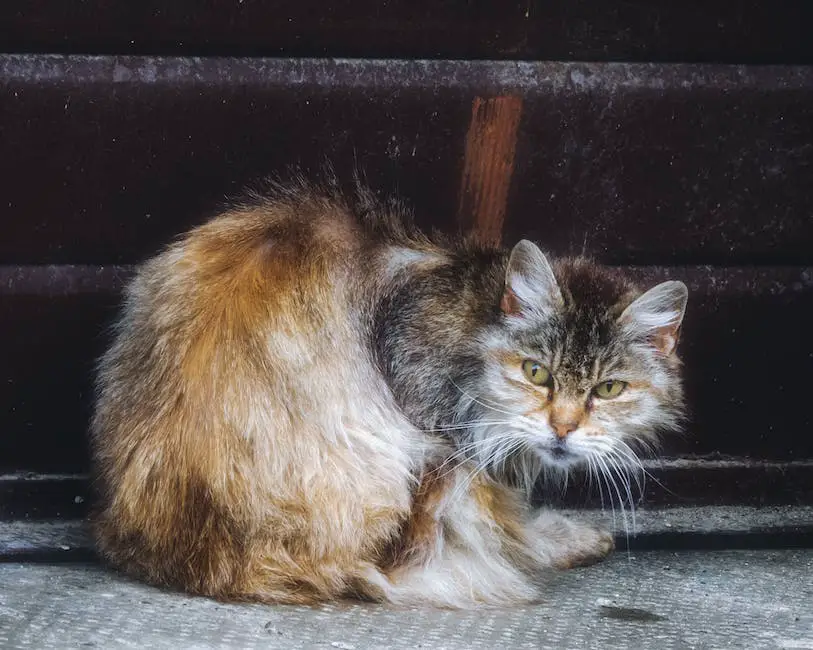Losing fur is a natural process for cats and usually happens when they’re shedding their winter coat to welcome the warmer weather. If your cat is suddenly shedding a lot more fur than usual, there could be an underlying health condition causing it. Here are some reasons why your cat might be shedding excessively and how you can help them.
There are a number of reasons that your cat may be shedding more than normal. One possibility is that the weather is changing and your cat is reacting to the temperature changes. Another possibility is that your cat is experiencing stress or anxiety, which can lead to increased shedding. Another possible reason is that your cat has an underlying medical condition that is causing the increased shedding. If you are concerned about your cat’s shedding, please consult your veterinarian for a definitive diagnosis.
Is it normal for indoor cats to shed a lot?
Shedding can often be a cause for concern, especially if your cat’s coat and skin looks and feels unhealthy. If your cat is obsessively self-grooming, biting themselves, coughing up more hairballs than usual, and has bald spots, it may be time to get help from a professional.
Brushing your cat daily can help reduce shedding and keep their fur healthy and looking good. Be sure to use the right comb or brush for the length and density of your cat’s fur, so you can avoid pulling the fur or making the experience uncomfortable.
How do I know if my cat is shedding too much
If your cat is vomiting or developing hairballs more often, it could be a sign of excessive hair loss. Don’t expect to see trails of hair all over the house, but if you see clumps of hair appearing regularly, it’s a red flag.
While dogs and cats shed year-round, shedding tends to reach a peak in the spring and fall, says PetHelpful. This is especially true for pets who spend a lot of time outdoors. In the fall, pets shed old hair growth to make room for new hair that will help them stay warm in the winter.
How can I control my cat hair in my house?
Dryer sheets are a wonderful way to remove hair from carpets and furniture. Simply dampen the sheet and rub it over the hairy surface. The hair will adhere to the sheet and come right off. Pumice stones are also great for removing hair from carpets. Just rub the stone over the hairy surface and the hair will come right off. For lint rollers or duct tape, simply roll or tape over the hairy surface and the hair will be removed.
If your cat is shedding more than usual, it could be a sign that they are feeling stressed or anxious. Look for other signs of a stressed cat, like hiding, trembling or litter box problems, and try to help them feel more relaxed. You could try adding a cat tree or some other type of enrichment to their environment, or even just spending more time petting and playing with them.
How long does cat shedding last?
If your cat is shedding excessively, it may be a sign that their circadian rhythm is off and they’re not getting enough natural sunlight. The shedding may last a few weeks to a couple of months. If your cat isn’t shedding at all, it might be worth a trip to the vet to check for underlying health issues.
This is great news for owners of long-haired felines since bathing them can help reduce shedding! Showering rinses away dead hair, but you can also achieve a similar result with brushing alone.
Do indoor cats shed more in winter
Cats’ fur coats adapt to the seasons, growing thicker in winter for warmth and thinner in summer for coolness. This process is regulated by exposure to sunlight. When there’s less sunlight, cats’ bodies produce more of a protein called melatonin, which triggers the growth of shorter, fluffier secondary hairs. These provide insulation against the cold. When there’s more sunlight, melatonin levels drop and the cats shed their thick winter coats. Indoor cats are exposed to less natural sunlight and more artificial light; their bodies lose track of seasonal changes, and they shed constantly year round.
There are a few cat breeds that are known to shed less than others. The Sphynx, Siberian, Bengal, Cornish Rex, and Siamese Bombay are all breeds that are known to be relatively low-shedding. This is due to a variety of factors, including their coat type and genetics. If you are looking for a cat that sheds less, one of these breeds may be a good option for you.
How much shedding for a cat is normal?
While cats shed every day, they will only go through large-scale sheds once or twice a year. This is due to various factors such as breed and environment. For example, cats that live in colder climates may shed more frequently than those in warmer climates.
To remove dead hair and tangles from your cat’s fur, first work along the lie of her fur, brushing in the direction the coat grows. Be sure to brush all over her body, including her chest and abdomen. Then, concentrate on one section at a time to remove any remaining dead hair or tangles. A rubber brush can be especially effective for removing dead hair on cats with short fur.
What removes cat hair from the air
If you have pets, an air purifier can help trap airborne pet hair and particles such as pet dander, bacteria, dust and lint. This can help reduce allergies and other respiratory problems caused by pet hair and other particles in the air.
As a cat owner, you’re probably all too familiar with the never-ending shedding cycle. Whether your cat has short hair or long hair, they are bound to shed all year long! The largest shedding periods usually occur around spring and fall, but you can find cat hair practically everywhere at any time of year. This is because cats are constantly cycling through hair, and it ends up everywhere! If you’re struggling to keep the Furminator brush under control, here are a few tips to help manage your cat’s shedding.
Can cats feel their owners stress?
We all know that animals can be attuned to our emotions – anyone who has ever been owned by a dog or cat can attest to that. But according to new research from Nottingham Trent University, cats also notice when we’re stressed out or anxious, and can be less healthy as a result.
The study, which is the first of its kind, found that when cats are around humans who are anxious or stressed, they also show signs of stress. And, over time, this can lead to health problems such as reduced immunity and digestion issues.
So, if you’re feeling stressed out, it’s not just you – your cat is likely picking up on your emotions and may be suffering as a result. Try to create a calm environment for both you and your feline friend, and if you’re feeling particularly stressed, consider seeking professional help.
Cats that shed a lot require regular grooming to help reduce the amount of hair that is shed. There are several types of cats that fit into this category, including the Chartreux, Maine Coon, Norwegian Forest Cat, Ragdoll, Russian Blue, and Siberian. Each of these breeds has their own unique coat that requires special attention.
Does coconut oil help with cat shedding
Coconut oil is a good way to condition the skin and coat of your cat to reduce shedding and prevent hairballs. Most cats like the taste of coconut oil and will eat it right off a spoon or in a bowl.
While you can use a lint roller on a cat, many professional groomers prefer not to. This is because lint rollers can be harsh on a cat’s delicate skin and fur. If you do use a lint roller on your cat, be sure to go slowly and be gentle.
Do cats like warm or cold houses
Cats are relatively tolerant of cold temperatures, but they prefer warmth. Rooms that hover between 50-60 degrees are not ideal for them, but they will be okay. You may notice your cat seeking out additional heat by snuggling up to a radiator, blanket, or you!
It’s normal for kittens to shed their baby fur and develop their adult coat sometime between the ages of 6 and 12 months. During this time of transition, you may notice an increase in shedding. But don’t worry, it’s all part of the process!
Why is my 9 month old cat shedding so much
Kitten fur sheds very little until they reach adulthood. Between the ages of 6 to 12 months, the coat begins to fall away to allow the adult coat to begin to grow.
Indoor cats will typically shed less than their outdoor counterparts due to the amount of artificial light and controlled temperature inside the house. However, they can shed at any time of the year. Outdoor cats, on the other hand, will typically shed in the spring when the days start to lengthen and they spend more time outside.
What is the hardest cat breed to take care of
Picking the right cat breed is important if you want a furry friend that will be a low-maintenance pet. However, some cat breeds are more difficult to take care of than others. The following are 25 of the hardest cat breeds to take care of:
1. American Bobtail – This breed is notorious for being independent and aloof, making them difficult to bond with. They are also known to be escape artists, so you’ll need to keep a close eye on them.
2. Japanese Bobtail – Another independent breed, Japanese Bobtails can be shy around strangers and are often resistant to being picked up or cuddled.
3. LaPerm – LaPerms are a high-energy breed that needs a lot of stimulation to keep them from getting bored. They are also known to be destructive if left to their own devices.
4. Selkirk Rex – Selkirk Rexes are a relatively new breed that is known for being very playful and outgoing. However, they can also be high-maintenance, as they require a lot of grooming to keep their hair looking its best.
5. Devon Rex – Devon Rexes are known for being mischievous and playful, but they can
Some of the least affectionate breeds of cats include the American Wirehair, Korat, Singapura and Cymric. The American Wirehair tends to be pretty reserved and quiet, which some would consider not particularly affectionate. The Korat is somewhat passive and can be spooked easily by loud noises.
Why are clumps of hair falling off my cat
There are many possible reasons why your cat may be losing its fur, which is known as alopecia. Allergies, hormone imbalances, and infestations of parasites are some of the most common causes. Thankfully, most of these causes are relatively easy to identify and treat. If your cat is experiencing hair loss, consult your veterinarian for a diagnosis and care plan.
A good de-shedding tool for cats should have fine to medium teeth and be 6 to 8 inches long, according to the National Cat Groomers Institute. This comb will remove the dead coat and catch all the tangles and mats that lie hidden underneath without irritating your cat’s delicate skin.
How do you get cat hair off blankets in the washing machine
If your blanket is ready for a washing, follow these simple steps:
1. Give the blanket a good shake to remove any lingering hairs.
2. Add ½ cup of white vinegar to the wash cycle to help loosen pet hair.
3. Run an empty wash cycle after washing the blanket to filter out fur and hair.
4. Wipe down the washer tub after the empty cycle.
Air purifiers can be a great way to remove pet hair and dander from the air, depending on the severity of the person’s allergies. In some cases, an air purifier may be enough to allow the person to be in the same room as the pet, or even to stay in the house for a weekend.
Warp Up
There could be a few reasons why your cat is shedding more than usual. If they are an indoor cat, they may be shedding due to the change in season. If they are an outdoor cat, they may be shedding due to stress or anxiety. Whatever the reason, you should consult your veterinarian to rule out any health concerns.
One potential reason your cat may be shedding more than usual is that they are either enjoying or seeking out more opportunities to scratch. Another possibility is that they are experiencing stress or anxiety, which can lead to excessive grooming and shedding. If your cat’s shedding seems excessive or is accompanied by other unexpected changes in behavior, it’s always best to consult with your veterinarian to rule out any potential health concerns.






